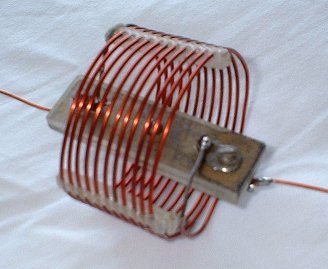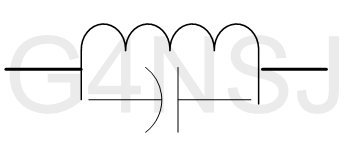The diagram below shows a trapped inverted L aerial for 40 and 80 metres. The overall length of the aerial is one quarter wave on 80 metres. From the feed point to the trap, the length is one quarter wave on 40 metres. When working on 80, the trap is insignificant as it acts as a short circuit. When working on 40, the trap acts as an insulator. So, we have two quarter wave aerials in one. No switching, no matching… Great stuff. Here’s how it works.
INVERTED L AERIAL
Forget the trap for a minute and look at the entire length of aerial as one quarter wavelength long on 80 metres. The feed impedance will be around 50 ohms, ideal for matching to 50 ohm coax without the need for an ATU.
Now look at the aerial and assume that the wire from the trap to the right hand mast is nylon string. What have we got? A quarter wave aerial for 40 metres. The feed impedance will be around 50 ohms. Ideal for matching to coax.
Now look at the aerial as it is shown in the diagram. On 80 metres, the trap is a short circuit and has no effect on the aerial. Actually, it acts as a small loading coil on 80 metres but forget that for the moment. On 40 metres, the trap acts as an insulator – the wire from the trap to the right hand mast doing nothing.
A trap is a parallel Inductor/Capacitor combination, resonant on a particular frequency. The 40 metre trap in our aerial described above is resonant around 7.100 MHz (the top end of the UK 40 metre band). Because the trap is resonant on 40 metres, it will present a high impedance on this band. In other words, it acts like an insulator.
 When operating on 80 metres, the trap will present a low impedance. In other words, it acts like short circuit and the entire length of the aerial will be in use. To be correct, the trap isn’t a short circuit on 80 metres. On this band, or any frequency below 40 metres, the trap behaves like a loading coil. This loading coil effect electrically shortens the aerial’s length. So, if the overall length of the aerial is around 60 feet, a quarter wave on 80 metres, then the loading coil effect of the trap will shorten this by a few feet.
When operating on 80 metres, the trap will present a low impedance. In other words, it acts like short circuit and the entire length of the aerial will be in use. To be correct, the trap isn’t a short circuit on 80 metres. On this band, or any frequency below 40 metres, the trap behaves like a loading coil. This loading coil effect electrically shortens the aerial’s length. So, if the overall length of the aerial is around 60 feet, a quarter wave on 80 metres, then the loading coil effect of the trap will shorten this by a few feet.
40 METRE TRAP
The aerial we’ve been talking about is great for 40 and 80 metres. But what about the other bands? Take a look at the diagram below. The overall length of the aerial is one quarter wave on 80 metres. The length from the feed point to the 40 metre trap is one quarter wave on 40 metres. This is exactly what we had in our last aerial, except this isn’t an inverted L configuration.
SEVERAL TRAPS
Work out a quarter wavelength of 10 metres from the feed point and stick a 10 metre trap in the aerial at this point. We now have a three-band aerial, 10, 40 and 80 metres. The ten metre aerial is the quarter wavelength of wire from the feed point to the 10 metre trap. This trap acts as an insulator at 10 metres and a short circuit on all lower bands.
Now measure along the wire from the feed point a quarter wavelength on 15 metres. Stick the 15 metre trap in the wire at this point and you have a four-band aerial. Do your measuring and stick in the 20 metre trap, and you’re on five bands.
You want a five-band dipole? Simple. Look at the diagram above as the right hand half of your dipole. From the feed point, mirror this aerial and feed the thing in the centre with 50 ohm coax. You now have a five band dipole with no ATU. Great stuff. And you must also have a pretty big garden!
The way to construct this aerial is to cut a length of wire which is one quarter wavelength long on 10 metres. Stick the 10 metre trap on the end of the wire and then trim the overall length of the wire for a one to one SWR in the centre of the 10 metre band – no ATU!
Then add a length of wire to the free end of the trap so that the whole aerial, including the trap, is a quarter wavelength long on 15 metres. Stick the trap on the end of your new length of wire and trim until the SWR is one to one on 15 metres.
And so on…
If you’ve not quite grasped the idea of traps, take another look at the diagram above. The 10 metre trap is an insulator on 10 metres. Move to the right and the 15 metre trap is an insulator on 15 metres – the 10 metre trap is now a short circuit. Move to the right and the 20 metre trap is an insulator on 20 metres – the 10 and 15 metre traps are now short circuits. Move to the right and the 40 metre trap is an insulator on 40 metres – the 10, 15 and 20 metre traps are now short circuits. Move to the right and you’ve come to the end of the aerial. At this point, all the traps are short circuits and the aerial is one quarter wavelength long on 80 metres.



